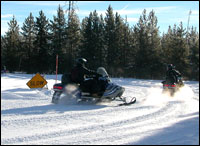
A vroom with a view.
Photo: Greater Yellowstone Coalition.
You might think a winter job in the snowy recesses of Yellowstone National Park would guarantee perks along the lines of, say, peace and quiet. Au contraire.
In light of a recent study conducted for the National Park Service, many Yellowstone employees are being advised to don hearing protection fit for a rock-and-roll roadie — all thanks to the relentless drone of snowmobiles in the park.
“The Bush administration tried to assure us that in the snowmobile issue, like so many others, technology is the answer — that simply upgrading engine technology was the answer to the snowmobile problem rather than prohibiting them altogether,” said Abigail Dillen, an attorney with Earthjustice. Dillen’s organization represents the Greater Yellowstone Coalition and other environmental groups in their lawsuit against the Bush administration for reversing a Clinton-era ban on snowmobiles in Yellowstone.
But Bush’s call for use of the “best available technology” has yet to result in the Prius of snowmobiles. Despite claims by the Interior Department that new four-stroke snowmobiles are far less noisy than older two-stroke models, critics charge that the new generation of machines has proven considerably more polluting — both in terms of emissions and noise — than promised.
In fact, the new four-stroke models are loud enough to damage hearing, according to internal park service documents obtained and released last week by the Coalition of Concerned National Park Service Retirees, a group of 230 retired employees and directors of the NPS.
The coalition released minutes from a meeting [PDF] from late January in which a Yellowstone safety officer, Brandon Gauthier, advised employees who drive the new four-stroke snowmobiles to wear earplugs because the machines are almost as loud as the two-stroke models, reaching a noise level of 111 decibels during acceleration. Because the decibel scale is logarithmic, that’s many times higher than the 85-decibel level at which medical experts advise the use of hearing protection.*
Officials at NPS headquarters did not respond to Muckraker’s repeated requests for comments. But it appears that the noise data hasn’t concerned them much, according to Bill Wade, a former superintendent of Shenandoah National Park and the coordinator of the Coalition of Concerned National Park Service Retirees. “The administration has known about this for nearly three months, but the Interior folks didn’t seem at all inclined to make this information available to the public,” he said. “So we took it into our own hands.”
The four-stroke decibel levels cited by Gauthier are chronicled in a conspicuously unreleased March study conducted for the NPS (see a data table [PDF] from the study). According to the retirees’ coalition, 18 of 20 tests measuring noise levels on or near snowmobiles found that those levels exceeded 100 decibels. Granted, a study with 20 samples is not comprehensive, but it was grounds enough for Yellowstone’s Safety Office to cite four-stroke snowmobiles in a recent employee newsletter [PDF] as a potential noise hazard that would necessitate hearing protection.
At least NPS employees are getting warning of the danger to their hearing. Park visitors who ride snowmobiles are not.

Yellowstone employees don masks — and, if they’re smart, earplugs too.
Photo: Greater Yellowstone Coalition.
Perhaps that’s because the administration is taking its cues from the International Snowmobile Manufacturers Association. The group’s president, Ed Klim, told Muckraker that the notion that four-stroke snowmobile engines pose a noise problem is “a lie — it’s just plain wrong.” He said, “I’m not a trained sound engineer, but I do ride snowmobiles, and I know they are quieter [than two-stroke models] — significantly quieter.”
So incensed is Klim by the coalition’s claims, he royally dissed the organization last week in an article in the Casper Star-Tribune as “old retired guys who don’t know anything.” As Klim told reporter Ted Monoson, “I wish they had done as much work when they were employed.”
Wade was not fazed by the aspersions. “I want to stand face-to-face with this Klim guy and ask: ‘What kind of scientific evidence do you have that disputes this [noise] data and shows that noise in a national park is tolerable and consistent with the values of Yellowstone?’ We have data that says it’s not,” he said.
This data is certain to be fodder for the ongoing legal battle between the Bush administration and the Greater Yellowstone Coalition, which won its initial lawsuit in a D.C. federal court, reversing the Bush administration’s effort to block Clinton’s snowmobile ban. That court’s decision has since been challenged by the snowmobile industry and the state of Wyoming, and the outcome of the Great Yellowstone Snowmobile Controversy still hangs in limbo.
“The question boils down to this,” said Wade. “Is any recreation machine that is noisy enough to potentially cause hearing damage appropriate in the world’s flagship national park? In my opinion, it’s not. The emphasis is supposed to be on preserving the natural quiet so we can hear the subtle sounds of Yellowstone — the wildlife, the geysers and mud pots.”
Perhaps that’s why some 90 percent of the hundreds of thousands of public comments on Clinton’s snowmobile ban supported the initiative.
*[Correction, 30 Apr 2004: This article originally stated that 111 decibels was 25 percent louder than 85 decibels. In fact, 111 decibels is many times louder than 85 decibels since the decibel scale is logarithmic.]

